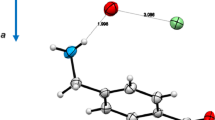Abstract
18-crown-6 reacts with TiCl3 in CH2Cl2 to form a complex in which the crown ether functions as a tridentate ligand. Addition of moist hexane affords a molecular complex in which the crown ether functions as a bidentate ligand. A water molecule is bonded directly to the titanium atom and is further hydrogen bonded to three of the oxygen atoms of the crown. The deep blue crystals of the CH2Cl2 adduct belong to the monoclinic space groupP21/n witha=13.481(8),b=8.021(5),c=21.425(9) Å, β=97.32(5)°, andρ calc = 1.51 g cm−3 forZ=4. Refinement led to a conventionalR value of 0.040 based on 873 observed reflections. The Ti−O bond distances for the crown oxygen atoms are 2.123(8) and 2.154(9) Å, while the oxygen atom of the water molecule is bonded at 2.072(8) Å. The octahedral coordination sphere of the titanium atom is completed by the three chlorine atoms at distances of 2.340(5), 2.352(4), and 2.373(4) Å.
Similar content being viewed by others
References
S. G. Bott, H. Elgamal, and J. L. Atwood: unpublished results, but see also S. G. Bott, H. Elgamal, and J. L. Atwood:J. Am. Chem. Soc. 107, 1796 (1985) and J. L. Atwood, H. Elgamal, G. H. Robinson, S. G. Bott, J. A. Weeks, and W. E. Hunter:J. Incl. Phenom. 2, 367 (1984).
J. L. Atwood:Inclusion Compounds vol. I (eds. J. L. Atwood, J. E. D. Davies, and D. D. MacNicol), pp. 395–426, Academic Press, London (1984).
ZrCl4 actually reacts with 18-crown-6, effecting an opening of the macrocyclic ring. See Part I, H. Prinz, S. G. Bott, and J. L. Atwood:J. Am. Chem. Soc., in press.
T. Sakurai, K. Kobayashi, S. Tsuboyama, Y. Kohno, N. Azuma, and K. Ishizu:Acta Crystallogr. C 39, 206 (1983)
P. G. Jones, T. Gries, H. Grutzmacher, H. W. Roesky, J. Schimkowiak, and G. M. Sheldrick:Angew. Chem. Int. Ed. Engl. 23, 376 (1984).
Spectra were taken as nujol mulls and recorded on a Perkin-Elmer 283 B infrared spectrometer.
J. Holton, M. F. Lappert, D. G. H. Ballard, R. Pearce, J. L. Atwood, and W. E. Hunter:J. Chem. Soc., Dalton Trans. 45 (1979).
SHELX, a system of computer programs for X-ray structure determination by G. M. Sheldrick (1976).
G. Germain, P. Main, and M. M. Woolfson:Acta Crystallogr. A27, 368 (1971).
S. G. Bott, H. Prinz, and J. L. Atwood: unpublished results.
W. C. Hamilton and J. A. Ibers:Hydrogen Bonding in Solids, p. 15, Benjamin, New York (1964).
Author information
Authors and Affiliations
Additional information
Supplementary Data relating to this article are deposited with the British Library as Supplementary Publication No. SUP 82034 (10 pages).
Rights and permissions
About this article
Cite this article
Bott, S.G., Kynast, U. & Atwood, J.L. Reaction of early transition metal complexes with macrocycles. II. Synthesis and structure of TiCl3(H2O) · 18-crown-6, a compound with a unique bidentate bonding mode for the 18-crown-6 molecule. Journal of Inclusion Phenomena 4, 241–246 (1986). https://doi.org/10.1007/BF00657997
Received:
Issue Date:
DOI: https://doi.org/10.1007/BF00657997




